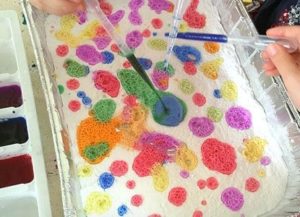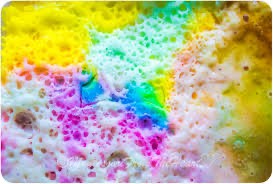This incredibly simple science experiment will truly mesmerize your child! Using only baking soda, vinegar and food colouring, your child can learn about chemical reactions. They will set off a bubbling, fizzing, colourful reaction, right before their eyes. Our students at CEFA Early Learning schools love it!
We like to do it over the light table, but it is not necessary.
Best Ages for This Activity
One to five
How to Make It
Ingredients
- A box of baking soda
- 2 cups of white vinegar
- Pipettes (these are the ones we use at CEFA Early Learning schools) – if you don’t have pipettes, get an old eye-dropper (they sometimes come in children’s medicine – please don’t use it for the medicine after you’ve used it for the experiment)
- 3 drops (per colour) of liquid food colouring of various colours (you can try it with just one colour, but I really encourage you to do it with at least 4 colours if not more). Any type of food colouring is fine.
- 1 container, tray or plate (use something that can get wet and can be washed)
- Small jars or an ice tray to put vinegar in (you will need one for each colour you are trying)
Let’s Get Started!
- Invite your child to try a science experiment
- Pour the baking soda into your container and shake it so it sits flat in your container and covers its surface as much as possible:

- Put a little vinegar in each jar (or in the ice tray) and add a few drops of food colouring in each container. Now you have your colour mixes.
- With the pipettes (you might want to use one per colour), encourage your child to pick up some vinegar solution and squeeze it over the baking soda… this will immediately start fizzing, to the amazement of your child:

- Did your child predict what was going to happen? What did happen?
- You can try it as many times as you want, each time adding a few drops of colourful vinegar to the baking soda.
Learning Opportunities
This is a thrilling S.T.E.M. activity where your child can see a chemical reaction as it happens. For better science learning, follow the steps of your scientific method with your child. Make sure you use as much math vocabulary as you can (for example, name the colours, observe if the colours mix, see if the bubbles get larger and faster if you put more vinegar on it, see what happens when you squish a whole pipette of liquid to the baking soda, etc.)
CEFA tip: Remember to let your child do as much of the process as they are capable of.
Books Your Child Might Like
Toys Your Child Might Like
For 3+
For 5+
As an Amazon Associate I earn from qualifying purchases